Ce3+/Ce4+-Doped ZrO2/CuO Nanocomposite for Enhanced Photocatalytic Degradation of Methylene Blue under Visible Light
Abstract
:1. Introduction
2. Materials and Methods
2.1. Preparation of the Ce3+/Ce4+-Doped ZrO2/CuO Nanocomposites
2.2. Characterization
2.3. Dye Photodegradation
3. Results
3.1. X-ray Diffraction
3.2. Microstructure and Morphology of ZrO2/CuO-Doped Ce3+/Ce4+ Nanocomposites
3.3. Fourier Transform Infrared Spectroscopy and Energy Dispersive X-ray Spectroscopy of the Ce3+/Ce4+-Doped ZrO2/CuO Nanocomposites
3.4. Nitrogen Adsorption-Desorption Isotherms of the Ce3+/Ce4+-Doped ZrO2/CuO Nanocomposites
3.5. UV-Vis Absorption Spectrum of Ce3+/Ce4+-Doped ZrO2/CuO Nanocomposites
3.6. Photocatalytic Activity of Ce3+/Ce4+-Doped ZrO2/CuO Nanocomposites
4. Conclusions
Author Contributions
Funding
Institutional Review Board Statement
Informed Consent Statement
Data Availability Statement
Acknowledgments
Conflicts of Interest
References
- Maheshwari, K.; Agrawal, M.; Gupta, A.B. Dye Pollution in Water and Wastewater. In Novel Materials for Dye-Containing Wastewater Treatment; Springer: Berlin/Heidelberg, Germany, 2021; pp. 1–25. [Google Scholar]
- Alharbi, O.M.L.; Khattab, R.A.; Ali, I. Health and environmental effects of persistent organic pollutants. J. Mol. Liq. 2018, 263, 442–453. [Google Scholar] [CrossRef]
- Anwer, H.; Mahmood, A.; Lee, J.; Kim, K.-H.; Park, J.-W.; Yip, A.C.K. Photocatalysts for degradation of dyes in industrial effluents: Opportunities and challenges. Nano Res. 2019, 12, 955–972. [Google Scholar] [CrossRef]
- Reddy, B.M.; Khan, A. Recent advances on TiO2-ZrO2 mixed oxides as catalysts and catalyst supports. Catal. Rev. 2005, 47, 257–296. [Google Scholar] [CrossRef]
- Fazl, F.; Gholivand, M.B. High performance electrochemical method for simultaneous determination dopamine, serotonin, and tryptophan by ZrO2–CuO co-doped CeO2 modified carbon paste electrode. Talanta 2022, 239, 122982. [Google Scholar] [CrossRef]
- Renuka, L.; Anantharaju, K.S.; Vidya, Y.S.; Nagaswarupa, H.P.; Prashantha, S.C.; Sharma, S.C.; Nagabhushana, H.; Darshan, G.P. A simple combustion method for the synthesis of multi-functional ZrO2/CuO nanocomposites: Excellent performance as Sunlight photocatalysts and enhanced latent fingerprint detection. Appl. Catal. B Environ. 2017, 210, 97–115. [Google Scholar] [CrossRef]
- Nanda, B.; Pradhan, A.C.; Parida, K.M. Fabrication of mesoporous CuO/ZrO2-MCM-41 nanocomposites for photocatalytic reduction of Cr (VI). Chem. Eng. J. 2017, 316, 1122–1135. [Google Scholar] [CrossRef] [Green Version]
- Guerrero-Araque, D.; Acevedo-Peña, P.; Ramírez-Ortega, D.; Calderon, H.A.; Gómez, R. Charge transfer processes involved in photocatalytic hydrogen production over CuO/ZrO2–TiO2 materials. Int. J. Hydrogen Energy 2017, 42, 9744–9753. [Google Scholar] [CrossRef]
- Rajendran, S.; Khan, M.M.; Gracia, F.; Qin, J.; Gupta, V.K.; Arumainathan, S. Ce3+-ion-induced visible-light photocatalytic degradation and electrochemical activity of ZnO/CeO2 nanocomposite. Sci. Rep. 2016, 6, 1–11. [Google Scholar] [CrossRef] [Green Version]
- Piña-Pérez, Y.; Tzompantzi-Morales, F.; Pérez-Hernández, R.; Arroyo-Murillo, R.; Acevedo-Peña, P.; Gómez-Romero, R. Photocatalytic activity of Al2O3 improved by the addition of Ce3+/Ce4+ synthesized by the sol-gel method. Photodegradation of phenolic compounds using UV light. Fuel 2017, 198, 11–21. [Google Scholar] [CrossRef]
- Akshatha, S.; Sreenivasa, S.; Parashuram, L.; Kumar, V.U.; Sharma, S.C.; Nagabhushana, H.; Kumar, S.; Maiyalagan, T. Synergistic effect of hybrid Ce3+/Ce4+ doped Bi2O3 nano-sphere photocatalyst for enhanced photocatalytic degradation of alizarin red S dye and its NUV excited photoluminescence studies. J. Environ. Chem. Eng. 2019, 7, 103053. [Google Scholar] [CrossRef]
- Dean, J.; Yang, Y.; Veser, G.; Mpourmpakis, G. CuZrO3: If it exists it should be a sandwich. Phys. Chem. Chem. Phys. 2021, 23, 23748–23757. [Google Scholar] [CrossRef] [PubMed]
- Donohue, M.D.; Aranovich, G.L. Classification of Gibbs adsorption isotherms. Adv. Colloid Interface Sci. 1998, 76, 137–152. [Google Scholar] [CrossRef]
- De, A.K.; Majumdar, S.; Pal, S.; Kumar, S.; Sinha, I. Zn doping induced band gap widening of Ag2O nanoparticles. J. Alloys Compd. 2020, 832, 154127. [Google Scholar] [CrossRef]
- Pelaez, M.; Nolan, N.T.; Pillai, S.C.; Seery, M.K.; Falaras, P.; Kontos, A.G.; Dunlop, P.S.M.; Hamilton, J.W.J.; Byrne, J.A.; O’Shea, K. A review on the visible light active titanium dioxide photocatalysts for environmental applications. Appl. Catal. B Environ. 2012, 125, 331–349. [Google Scholar] [CrossRef] [Green Version]
- Sapawe, N. Hybridization of zirconia, zinc and iron supported on HY zeolite as a solar-based catalyst for the rapid decolorization of various dyes. New J. Chem. 2015, 39, 4526–4533. [Google Scholar] [CrossRef]
- Schneider, J.; Matsuoka, M.; Takeuchi, M.; Zhang, J.; Horiuchi, Y.; Anpo, M.; Bahnemann, D.W. Understanding TiO2 photocatalysis: Mechanisms and materials. Chem. Rev. 2014, 114, 9919–9986. [Google Scholar] [CrossRef]
- Wang, X.; Zhai, B.; Yang, M.; Han, W.; Shao, X. ZrO2/CeO2 nanocomposite: Two step synthesis, microstructure, and visible-light photocatalytic activity. Mater. Lett. 2013, 112, 90–93. [Google Scholar] [CrossRef]
- Raees, A.; Jamal, M.A.; Ahmed, I.; Silanpaa, M.; Saad Algarni, T. Synthesis and characterization of CeO2/CuO nanocomposites for photocatalytic degradation of methylene blue in visible light. Coatings 2021, 11, 305. [Google Scholar] [CrossRef]
- Ansari, S.; Khan, M.; Omaish, M.; Kalathil, S.; Lee, J.; Cho, M. Band gap engineering of CeO2 Nanostructure by electrochemically active biofilm for visible light applications. RSC Adv. 2014, 4, 16782–16791. [Google Scholar] [CrossRef]
- Khan, M.M.; Ansari, S.A.; Pradhan, D.; Han, D.H.; Lee, J.; Cho, M.H. Defect-induced band gap narrowed CeO2 nanostructures for visible light activities. Ind. Eng. Chem. Res. 2014, 53, 9754–9763. [Google Scholar] [CrossRef]
- Nuengmatcha, P.; Porrawatkul, P.; Chanthai, S.; Sricharoen, P.; Limchoowong, N. Enhanced photocatalytic degradation of methylene blue using Fe2O3/graphene/CuO nanocomposites under visible light. J. Environ. Chem. Eng. 2019, 7, 103438. [Google Scholar] [CrossRef]
- Acedo-Mendoza, A.G.; Infantes-Molina, A.; Vargas-Hernández, D.; Chávez-Sánchez, C.A.; Rodríguez-Castellón, E.; Tánori-Córdova, J.C. Photodegradation of methylene blue and methyl orange with CuO supported on ZnO photocatalysts: The effect of copper loading and reaction temperature. Mater. Sci. Semicond. Process. 2020, 119, 105257. [Google Scholar] [CrossRef]
- Van Huan, P.; Tam, P.D.; Pham, V.H. Visible-Light Photocatalysts of ZrO2/AgCl: Eu3+ Nanoparticles. J. Electron. Mater. 2019, 48, 5294–5300. [Google Scholar] [CrossRef]
- De Moraes, N.P.; de Azeredo, C.A.S.H.; Bacetto, L.A.; da Silva, M.L.C.P.; Rodrigues, L.A. The effect of C-doping on the properties and photocatalytic activity of ZrO2 prepared via sol-gel route. Optik 2018, 165, 302–309. [Google Scholar] [CrossRef]
- Zheng, J.; Sun, L.; Jiao, C.; Shao, Q.; Lin, J.; Pan, D.; Naik, N.; Guo, Z. Hydrothermally synthesized Ti/Zr bimetallic MOFs derived N self-doped TiO2/ZrO2 composite catalysts with enhanced photocatalytic degradation of methylene blue. Colloids Surf. A: Physicochem. Eng. Asp. 2021, 623, 126629. [Google Scholar] [CrossRef]
- Das, R.S.; Warkhade, S.K.; Kumar, A.; Wankhade, A.V. Graphene oxide-based zirconium oxide nanocomposite for enhanced visible light-driven photocatalytic activity. Res. Chem. Intermed. 2019, 45, 1689–1705. [Google Scholar] [CrossRef]
- Majumder, D.; Chakraborty, I.; Mandal, K.; Roy, S. Facet-dependent photodegradation of methylene blue using pristine CeO2 nanostructures. ACS Omega 2019, 4, 4243–4251. [Google Scholar] [CrossRef] [Green Version]
- Zeleke, M.A.; Kuo, D.H. Synthesis and application of V2O5-CeO2 nanocomposite catalyst for enhanced degradation of methylene blue under visible light illumination. Chemosphere 2019, 235, 935–944. [Google Scholar] [CrossRef]
- Quang, D.A.; Toan, T.T.T.; Tung, T.Q.; Hoa, T.T.; Mau, T.X.; Khieu, D.Q. Synthesis of CeO2/TiO2 nanotubes and heterogeneous photocatalytic degradation of methylene blue. J. Environ. Chem. Eng. 2018, 6, 5999–6011. [Google Scholar]
- Yu, Z.; Chuang, S.S. Probing methylene blue photocatalytic degradation by adsorbed ethanol with in situ IR. J. Phys. Chem. C 2007, 111, 13813–13820. [Google Scholar] [CrossRef]
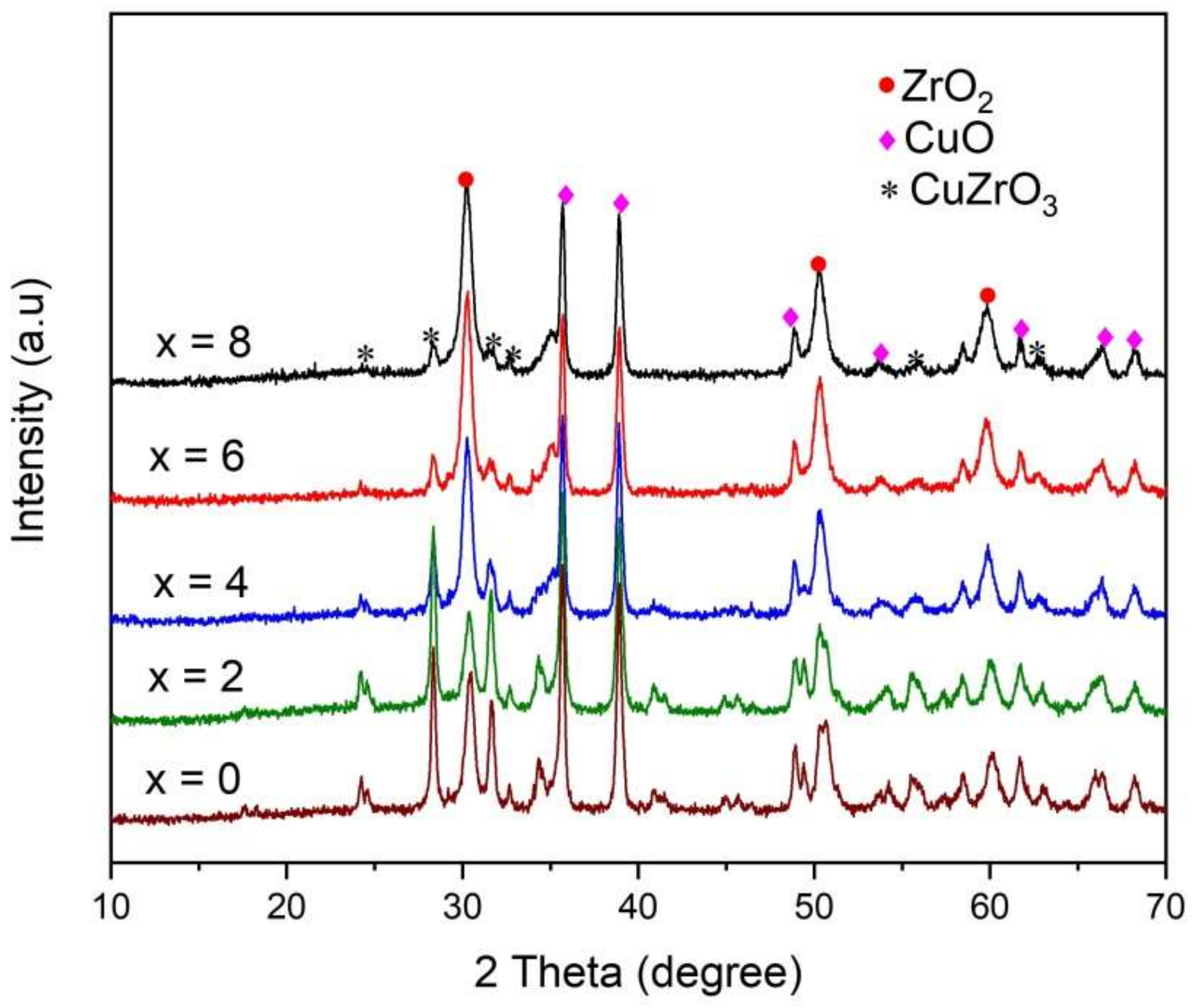


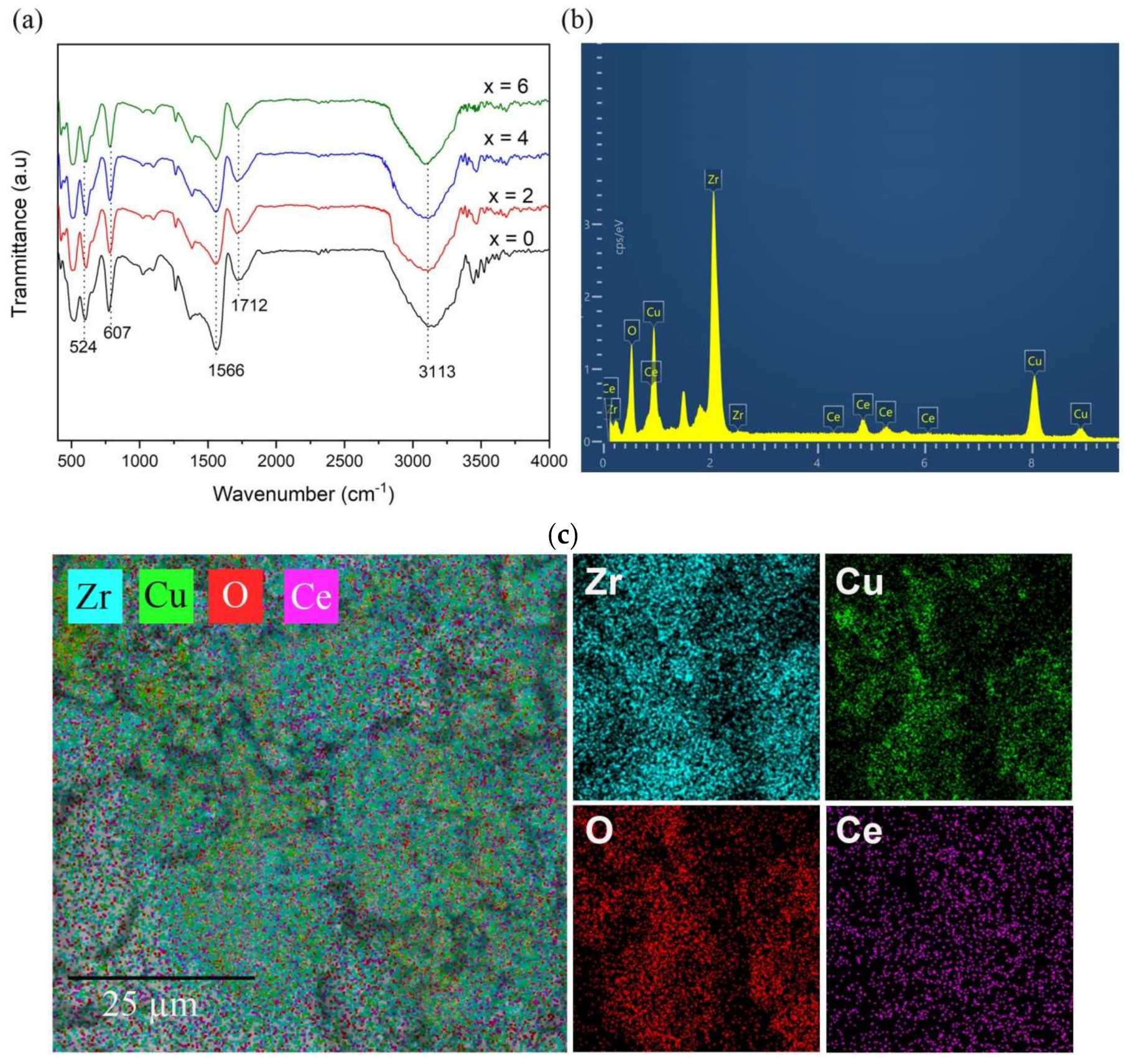
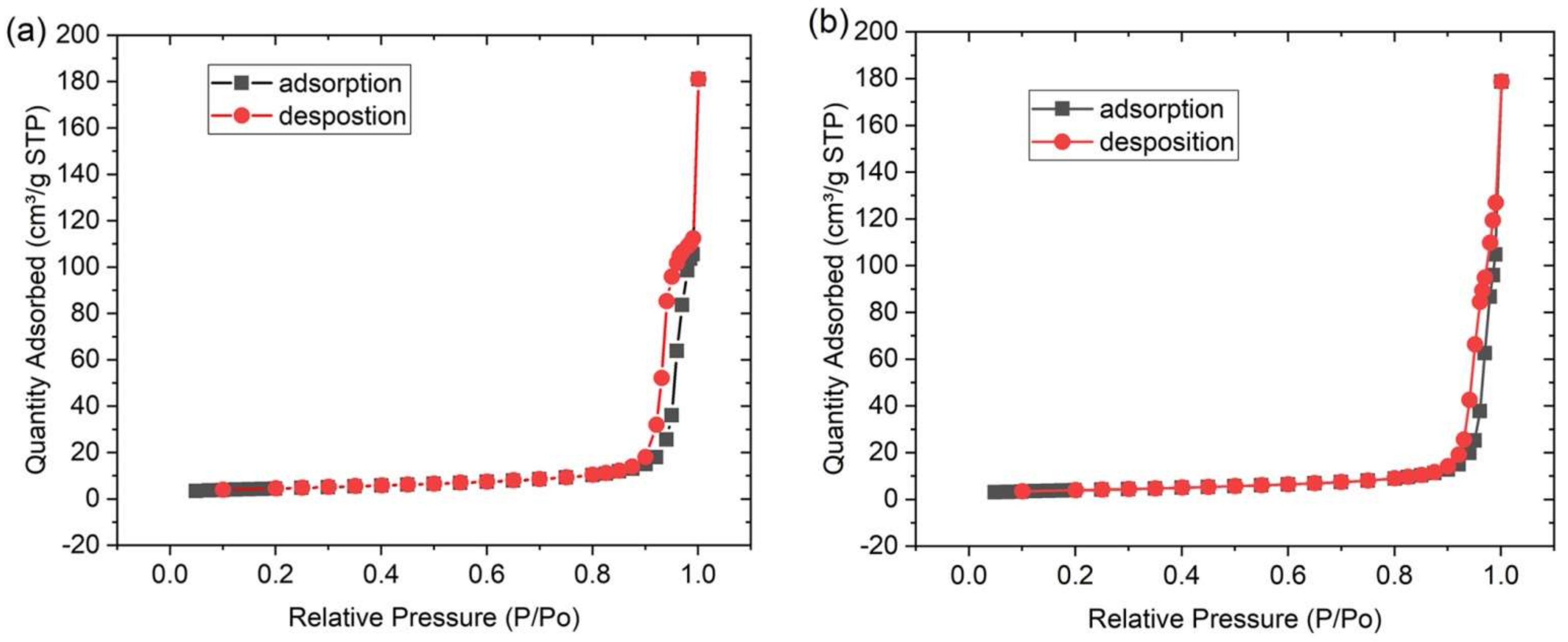


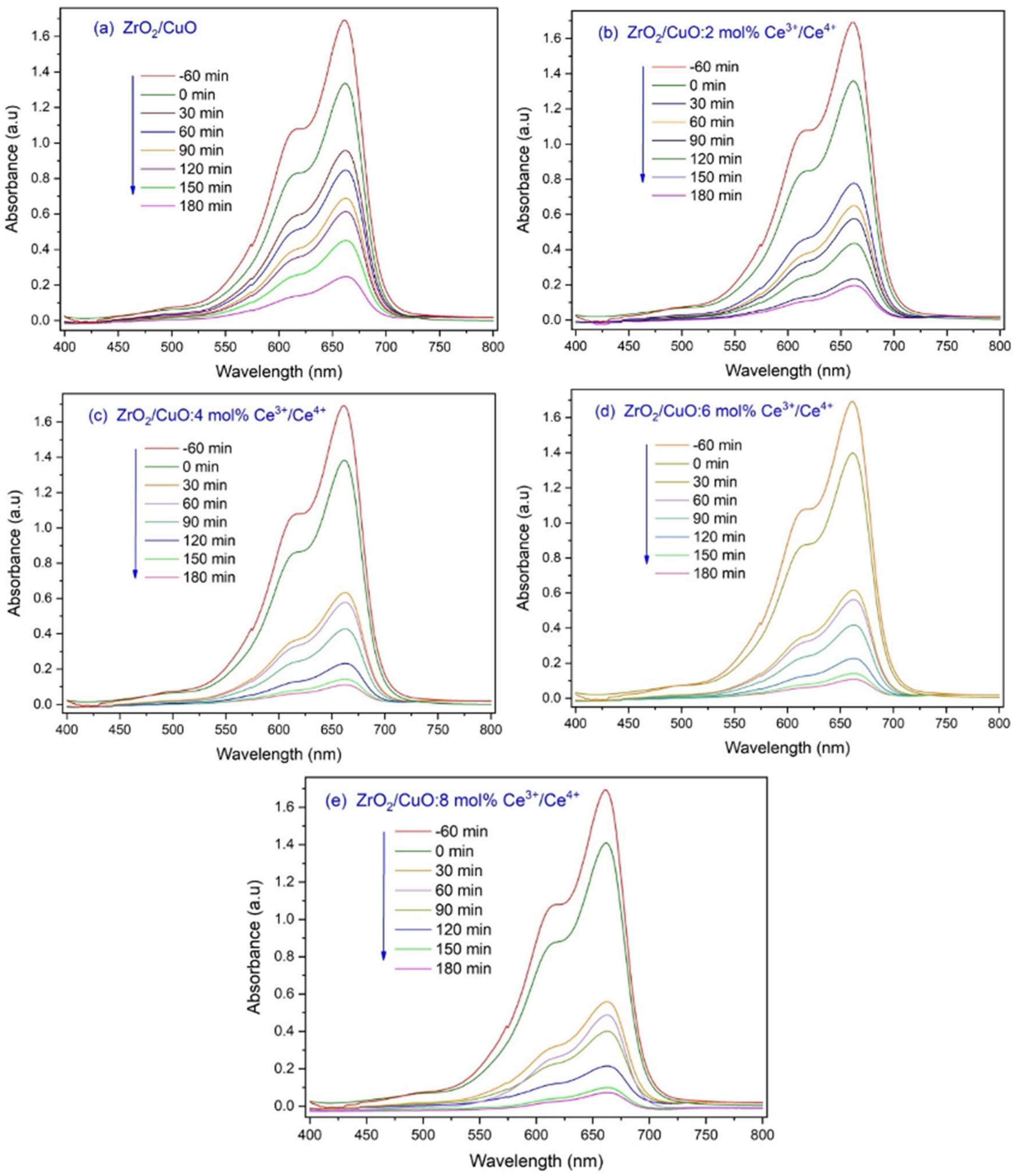

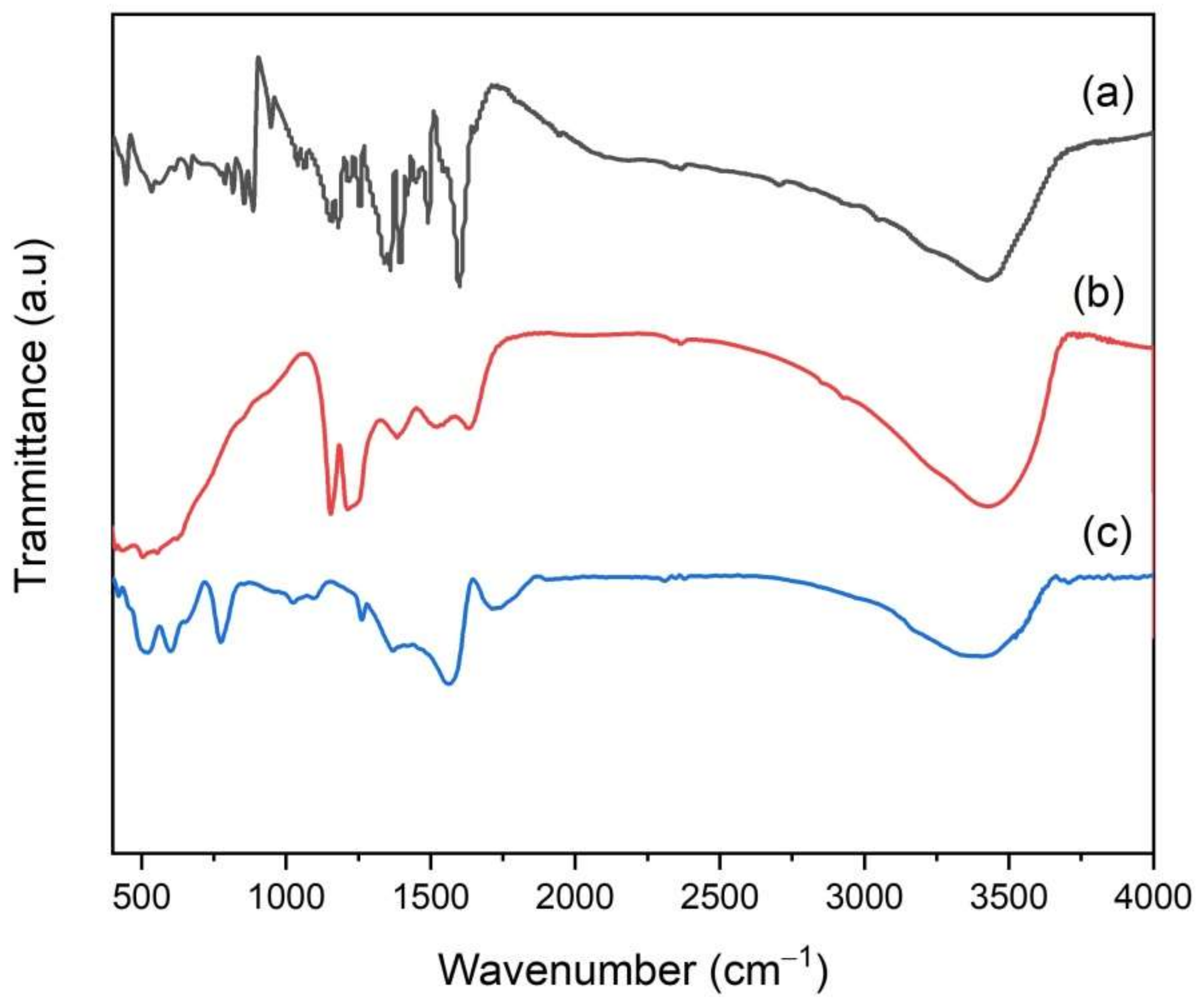
| Photocatalyst | Synthesis Method | Light Source | Rate Constant (min−1) | Reference |
|---|---|---|---|---|
| Fe2O3/graphene/CuO | Solvothermal | Visible | 72.5 × 10−3 | [22] |
| CuO/ZnO | Impregnation | UV lamp | 182 × 10−3 | [23] |
| ZrO2/AgCl:Eu3+ | Sol-gel | Visible | 14 × 10−3 | [24] |
| C-doped ZrO2 | Sol-gel | UVC lamp | 7.3 × 10−3 | [25] |
| N-TiO2/ZrO2 | Hydrothermal | UV light | 29 × 10−3 | [26] |
| ZrO2/CuO | Combustion | Visible | 11.19 × 10−3 | [6] |
| GO-ZrO2 | Co-precipitation | Visible | 57.5 × 10−3 | [27] |
| CeO2 | Precipitation | UV light | 12.1 × 10−3 | [28] |
| V2O5-CeO2 | Precipitation | Visible | 108 × 10−3 | [29] |
| CeO2/TiO2 | Precipitation | Visible | 34 × 10−3 | [30] |
| Ce3+/Ce4+-doped ZrO2/CuO | Hydrothermal | Visible | 13.8 × 10−3 | This work |
Publisher’s Note: MDPI stays neutral with regard to jurisdictional claims in published maps and institutional affiliations. |
© 2022 by the authors. Licensee MDPI, Basel, Switzerland. This article is an open access article distributed under the terms and conditions of the Creative Commons Attribution (CC BY) license (https://creativecommons.org/licenses/by/4.0/).
Share and Cite
Chu, M.N.; Nguyen, L.T.H.; Truong, M.X.; Do, T.H.; Duong, T.T.A.; Nguyen, L.T.T.; Pham, M.A.; Tran, T.K.N.; Ngo, T.C.Q.; Pham, V.H. Ce3+/Ce4+-Doped ZrO2/CuO Nanocomposite for Enhanced Photocatalytic Degradation of Methylene Blue under Visible Light. Toxics 2022, 10, 463. https://doi.org/10.3390/toxics10080463
Chu MN, Nguyen LTH, Truong MX, Do TH, Duong TTA, Nguyen LTT, Pham MA, Tran TKN, Ngo TCQ, Pham VH. Ce3+/Ce4+-Doped ZrO2/CuO Nanocomposite for Enhanced Photocatalytic Degradation of Methylene Blue under Visible Light. Toxics. 2022; 10(8):463. https://doi.org/10.3390/toxics10080463
Chicago/Turabian StyleChu, Manh Nhuong, Lan T. H. Nguyen, Mai Xuan Truong, Tra Huong Do, Thi Tu Anh Duong, Loan T. T. Nguyen, Mai An Pham, Thi Kim Ngan Tran, Thi Cam Quyen Ngo, and Van Huan Pham. 2022. "Ce3+/Ce4+-Doped ZrO2/CuO Nanocomposite for Enhanced Photocatalytic Degradation of Methylene Blue under Visible Light" Toxics 10, no. 8: 463. https://doi.org/10.3390/toxics10080463
APA StyleChu, M. N., Nguyen, L. T. H., Truong, M. X., Do, T. H., Duong, T. T. A., Nguyen, L. T. T., Pham, M. A., Tran, T. K. N., Ngo, T. C. Q., & Pham, V. H. (2022). Ce3+/Ce4+-Doped ZrO2/CuO Nanocomposite for Enhanced Photocatalytic Degradation of Methylene Blue under Visible Light. Toxics, 10(8), 463. https://doi.org/10.3390/toxics10080463






